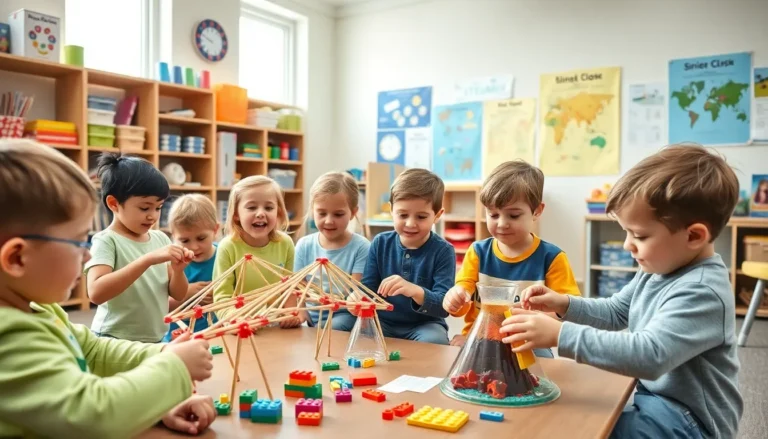Table of Contents
ToggleImagine a world where playtime becomes a hotbed of learning. Yes, that’s right. STEAM activities for preschoolers are not just fun, they’re an essential way to nurture curious little minds. From exploding volcanoes to crafting sturdy bridges, these activities fuel creativity and develop problem-solving skills in a light-hearted manner. And who doesn’t love the mischievous addition of a little mess? Buckle up: we’re diving into a galaxy of engaging, educational experiences that make preschool learning a blast.
Understanding STEAM Education

STEAM stands for Science, Technology, Engineering, Arts, and Mathematics. This holistic approach encourages preschoolers to explore concepts from various perspectives. Rather than segregating subjects into tidy little boxes, STEAM education helps young learners to see connections between different fields. Imagine children experimenting with colors in art while learning about mixing shadows in science: it’s the beauty of interdisciplinary learning. By blending creativity with analytical skills, kids are better prepared for the complex world that lies ahead.
Benefits Of STEAM Activities For Young Learners
Engaging in STEAM activities provides myriad benefits. First up is critical thinking. When youngsters tackle a problem, whether it’s building a structure that can withstand an earthquake (thanks, engineering.) or figuring out how to produce the best bubble solution (science magic.), they develop essential reasoning skills.
Also, teamwork is given a major boost. Many STEAM projects are best tackled in groups, effectively teaching preschoolers how to collaborate and communicate their ideas. Let’s not forget about boosting confidence. Every successful project ignites excitement and prompts little ones to embrace challenges head-on. In a nutshell, STEAM activities equip children with the tools they need to flourish in all aspects of life.
Creative STEAM Activities For Preschoolers
Get ready to turn everyday moments into immersive learning adventures. Here’s a treasure trove of creative STEAM activities:
Science-Based Activities
Spark interest with a simple experiment like making slime. Measuring ingredients combines science with math, and there’s nothing quite like the squishy outcome to keep them engaged. Or perhaps a DIY volcano, where vinegar and baking soda fuel mini eruptions. Nature walks, where kids observe plants and animals, can also lead to intriguing discussions about ecosystems.
Technology-Driven Projects
Introduce simple coding games or apps tailored for preschoolers. Many programs allow kids to drag and drop commands to make characters move, offering a delightful, tech-savvy twist to traditional learning. A scavenger hunt on a tablet can also incorporate augmented reality, turning the living room into an interactive playground.
Engineering Challenges
Try building bridges with everyday materials like popsicle sticks or LEGO. Kids will not just have fun but also learn about balance and weight distribution. Another cool activity is constructing a boat from a piece of aluminum foil, then testing its buoyancy with pennies, let the sinking and floating games begin.
Art Integration
Art is a natural for STEAM. Have kids experiment with different painting techniques to explore color mixing. They might even trace the shadows of toys or plants to understand light and shape. Creating a mixed media collage combining found objects can beautifully bridge science and art.
Mathematics Concepts Through Play
Transform math into a riveting game. Pair measuring cups with water play, turning simple pouring tasks into fun measuring exercises. Sorting shapes and sizes while playing with building blocks allows kids to grasp mathematical concepts naturally. Whether counting apples or creating patterns, math can be a playful adventure.
Tips For Implementing STEAM Activities At Home
Execution is key. Here are some pragmatic tips for integrating STEAM activities seamlessly into your home.
- Start Simple: Begin with materials easily available around the house. Recycled materials, kitchen supplies, and even nature can serve as your learning arsenal.
- Follow Their Lead: Pay attention to what interests your preschooler. If they’re fascinated by dinosaurs, plan a themed week around paleontology.
- Create a Learning Space: Dedicate a corner of your home for STEAM activities. It could be as simple as a table filled with craft supplies and science tools.
- Make It Routine: Regularly incorporate these activities into your day. Whether it’s a Friday ‘experiment day’ or science during snack time, consistency fosters curiosity.
- Ask Open-Ended Questions: Encourage deeper thinking by asking “why” and “what if” questions. This prompts them to explore ideas further and enhances critical thinking.






